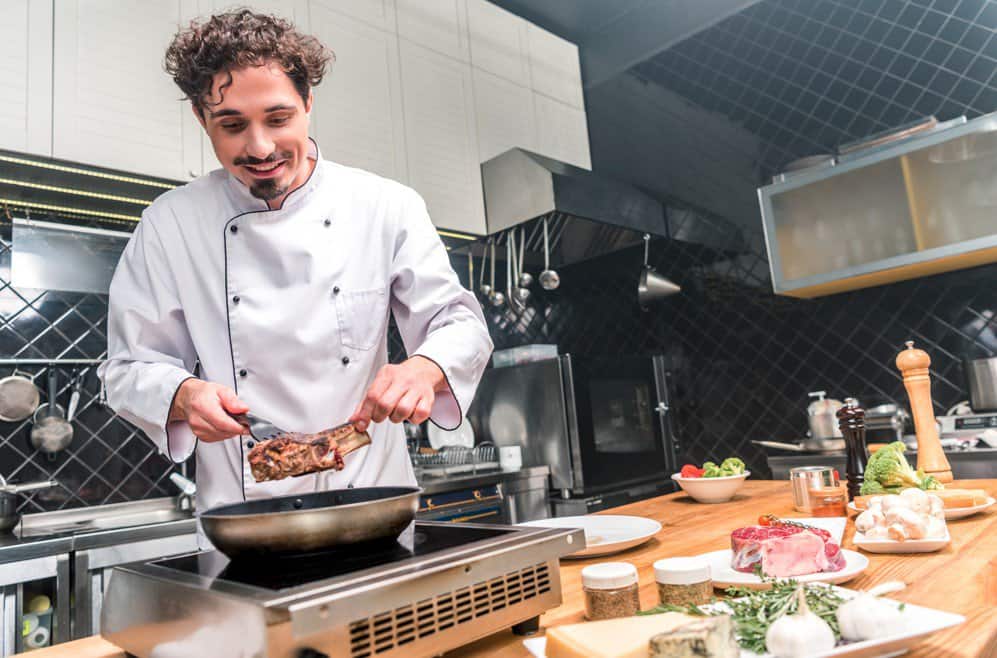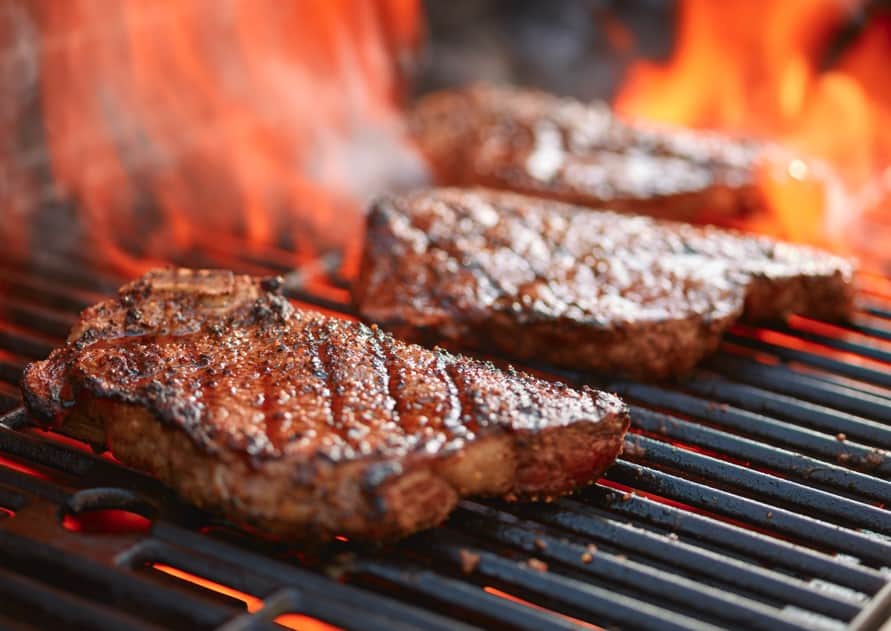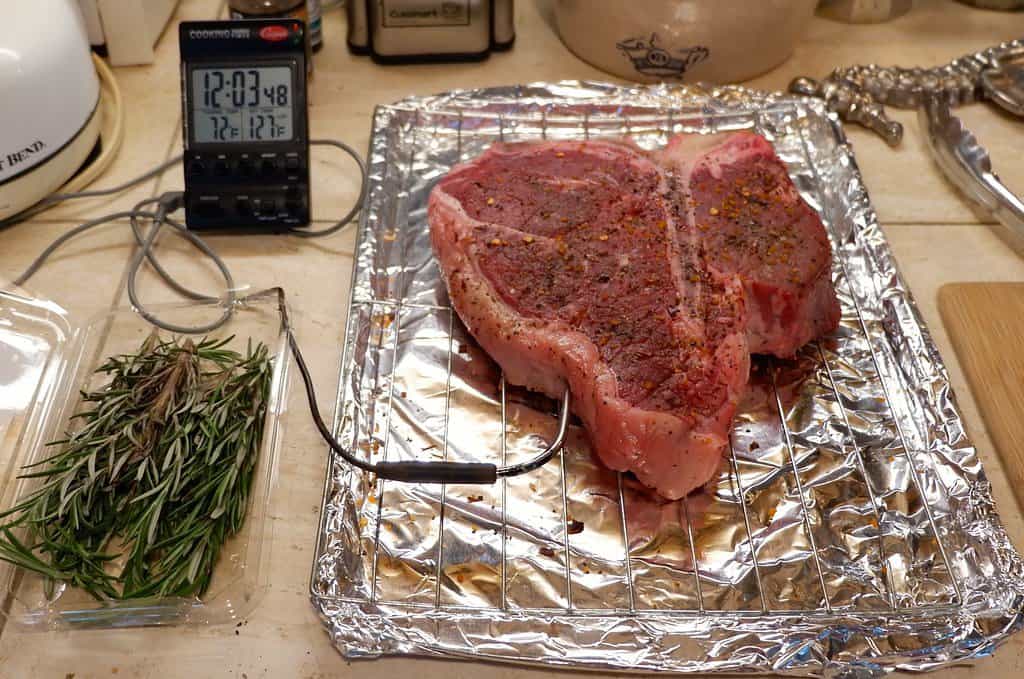- How to Cook Steak on a Pellet Grill: The Ultimate Grilling Medium - November 24, 2022
- How to Cook Wagyu Picanha - November 23, 2022
- How to cook a shell steak: An Uncommon Yet Delicious Cut - November 21, 2022
If you happen upon a Shell Steak you may mistake it for its boneless counterpart, the New York Strip Steak! Cut from the short loin, this cut of steak keeps the bone in for maximum flavor and presentation. Due to this bone, there are many advantages in regards to the flavor it offers.
Flavors of the bone during the cooking process will seep into the rest of the meat, enhancing flavor that a boneless steak simply CANNOT provide. This is why when faced with the New York Strip or Shell, I almost always go Shell.
Shell Steaks are great for grilling. The marrow in the bone melts into the proteins and you can get some great sear marks if you do it correctly. We will go over how exactly to cook this steak, not only on the grill but throughout your kitchen.
The Many Ways To Cook The Shell Steak

The bottom line is that there are a variety of ways to cook the Shell Steak, not just in cooking applications but also in seasoning and marinades. In this article, I will walk you through the many paths to a delicious Shell Steak you may find yourself on. I will also share some of my favorite ways to serve it in a meal.
What Are The Different Ways To Cook A Shell Steak?
Below is a list of ways that you can cook a Shell Steak. I will call out my personal favorites as we break them down even further. To start, here are some of the methods that work best with this cut of meat.
- Pan-Fry
- Grill
- Reverse Sear
- Sous Vide
Pan-Fry

The key to cooking this steak is really high heat and precise temperature monitoring. Shell Steaks are medium sized when it comes to the width, so overcooking is definitely a possibility.
The first step in pan frying a Shell Steak is to take it out of the fridge around 30 minutes before you are ready to cook it. This will allow it to temper, meaning it will lose that chill it had in the fridge. This will make the steak more forgiving when you cook it, as the inside temperature will not be ice cold as it would be straight out of the fridge.
The temperature of the pan is integral to the flavor of the steak. If the pan is too cold, the steak will stick and the steak touching the pan will steam, not sear. Additionally, it is the high temperature which causes the Maillard Reaction on the steak. This is the process of amino acids and sugars on the surface of the meat reducing down to create that seared flavor we all love.
Do not season your steak until right before frying! This is a common mistake some home cooks make, putting salt and pepper on the steak and letting it sit for some time. The salt will draw the moisture out and you will end up with a drier cut of meat. You will want to also pat the steak dry for maximum sear.
Once you are ready to cook, heat a skillet or pan on high and add in around 2 tablespoons of oil. You will want to use a vegetable or canola oil, as olive oil burns at high temperatures. Wait for the pan to emit a white smoke. When you see this smoke, you know your pan is hot enough.
Season your steak with salt and pepper, then place into the pan, letting it fall away from your hand so the oil does not splash back up and burn you. Sear on one side for 2 minutes, flip, and then sear for another 2. You then want to lower the heat and cook until it is at an internal temperature of 130-135F. Once this is done, take it off the heat and let it rest on a cooling rack.
It is important to let the steak rest due to the juices inside the steak still boiling around. When you pull a piece of meat off of the heat, all of that energy keeps active. Allowing to rest allows the energy to settle, the color to even out and the juice to remain locked in.
Once this resting period is over you can serve. You should have a nice, caramelized exterior with a pink interior. Cooking this steak beyond medium is not recommended as it is particularly lean and will become tough the more it is cooked.
Grill

Grilling a Shell Steak will hold the same type of thought process as the pan frying method with some minor changes. Grills are a great way to add a smoky, charred flavor to the Shell Steak. You also can play around with various types of wood to create different flavors.
Some great woods you can grill over are:
- Cherry
- Oak
- Pecan
- Mesquite
- Hickory
You can also use charcoal to achieve a great grilled steak as well. Finally, gas grills do offer another opportunity for this method if that is all you have. It really depends on what your tastes are and what you have on hand. I personally love grilling over hickory.
To grill, you will want to follow the same guidelines as we did for the pan in regards to pulling the steaks out around 30 minutes before cooking to allow them to temper. Get the grill going and ensure it is heated thoroughly. Again, a cold grill will cause the steaks to stick and you will be left with sub-par product.
It is important when grilling to know your grill and how it heats. Many pros in the restaurant world who work grill know their grate’s landscape like the back of their hand. Knowing which spots get hotter and which stay cooler is a super useful way to master heat control on a grill.
Once your grill is hot, brush the steaks with oil and season with salt and pepper. Place the steaks on the hottest part of the grill and sear for about 3 minutes. Flip the steaks and sear for another 3 minutes and then cook until the internal temperature is 130-140F. Let the steaks rest before slicing and enjoy.
Reverse Sear

The Reverse Sear method is one that many home cooks do not know of, and it is a shame as it allows for overall better control of the temperature of the protein during the cooking process. The idea is that you start the steak in the oven, slowly heating it and bringing it to temp. Then, you simply sear on both sides and voila, the steak is done.
To start this process, preheat an oven to 275F. You will want a rack directly in the center of the oven. Grab a half sheet tray with a metal rack and set aside. Brush the steak with oil and then season with salt and pepper. Place in the oven and cook to around 100F internally.
The beauty of this method is that you have two options. You could sear in a preheated pan OR you can sear on a preheated grill. The choice is up to you, but I personally prefer the grill to achieve that smoky, caramelized crust.
Once the steaks come out of the oven, sear on both sides and bring to your desired temp. Resting for about 5 minutes after the cook still applies here, so be sure you allow time for this as well.
The slow-cooked process should yield a steak that is tender, flavorful and caramelized. One of the major benefits of this method is that the surface of the steak dries out, leading to a beautifully deep sear if done properly.
Sous-Vide
The final method I would like to share on cooking the Shell Steak is the Sous-Vide method. The idea behind this cooking technique is to vacuum seal a protein in a waterproof bag and then to submerge it in water. You then cook the steak slowly in the water bath, allowing for the flavors to meld and the meat to become extra tender.
I personally use the Anova Sous Vide Precision Cooker in my own kitchen, and I find that it works great for the many uses I have for it. The great feature for using this technique is that you can put other ingredients into the bag with your cut of meat to enhance flavor.
Many chefs will add in herbs, shallots, garlic, onions, butters and other delicious ingredients in order to add flavor and tenderize the protein even more. Whatever you are adding, be sure to season the steak before this process so the flavors meld together.
You will set up the machine by placing it in a water bath. I like to set my temperature to 130F. I will then submerge the steak in the bag and cook for 2 hours. After 2 hours I will pull out, pat dry and sear on both sides. Ensuring the temp is 135F, I take it off of the heat and let it rest. You will have a perfectly cooked Shell Steak after this process.
Marinades

Why should we marinade proteins? The answer is one that has two different meanings. We marinade to add flavor to a protein, but we also can marinade to tenderize a steak too. Chefs utilize marinades not only to enhance flavor, but to improve texture on a steak.
The Shell Steak is consistently pretty tender, mostly due to some great marbling that occurs throughout the protein. It will not be as tender as a Ribeye, but will definitely not be tough if handled with care. So while you may want it to be more tender with a marinade, I would personally stick with adding flavor over trying to affect the toughness of this particular cut.
Components of a Marinade
A marinade will have three components to it:
- Acid
- Oil
- Seasoning
With this in mind, the opportunity for great marinades are endless. If you use this as a framework on the way forward, you will not be disappointed in the outcome. I really enjoy this Korean BBQ Marinade from Honest Food Talks. It does a great job of blending delicious ingredients in order to get a great end product.
How Not To Cook The Shell Steak
Given that this cut is bone-in, it should go without stating that cutting the meat of the bone is a waste of time and ruins this specific cut. I would not cut this steak into pieces and cook it, as the marbling in the meat is not enough to where cooking small pieces will leave a tender product.
I would also stay away from anything that avoids the sear or steams the product. Baking low without searing, cooking in a liquid and and frying are all techniques that will lead to a less than desirable product.
FAQs
Answer: The reason behind the name is simple enough. As the cut is taken off of the loin, a piece of the shell bone remains. Hence the name of this delicious cut of meat.
Answer: The reason the Shell Steak is not as common as the Strip Steak is due to the bone within it. Most consumers in the States look for boneless Steaks, and over the years many have been persuaded to not deal with the bone. The sad part is that it is the bone that offers so much flavor and it is why you should try cooking this steak.
Answer: The shell steak is a solid medium when it comes to fat density within the steak. It is less than a ribeye but more than a filet, so when cooking it will have flavor but can be overcooked if not handled correctly. This fat density does add some great flavor when cooking.
The Shell Steak: A Delicious Cut With Many Opportunities
Just because you may not know much about an ingredient doesn’t mean you cannot experience eating it. Here at The Art of Grill, we love to grill our proteins after marinating. We choose tasty woods to grill over and take pride in our craft to deliver the perfect steak.
But there is so much that can be done with this cut. Between cooking methods, seasonings, types of marinades and cooking mediums there is an endless array of ways to cook the Shell Steak. Try some of the techniques in this blog and be sure to share your thoughts on your perfectly cooked Shell Steak.

